Look Out for These Pests
Did you know that there are over 400 species of pests in our area?
There are over 400 species of pests in our area. As our population continues to grow, the more we will come in contact with many of these species. Pests compete with humans for living space and food. If pests are left unchecked their ability to quickly multiply can become a devastating problem. We at H&H Pest Control believe the more you know about the pests in our area the better armed you will be with the knowledge on how to spot them and report them before they damage your dwelling and injure people.

Bald Faced Hornet
The bald-faced hornet is a stinging insect related to the yellowjacket, notable for its black body and distinct white-patterned face. Known for their nests suspended above ground, it's essential to recognize signs of an infestation and prevent any unwelcome encounters. Key points to remember:
Bald-faced hornets are large, black-bodied insects with white-patterned faces.
They build suspended nests, with worker hornets present for protection, indicating an infestation.
Sealing up tiny cracks or openings in your home can prevent hornet invasions.
Keeping food covered outdoors and limiting strong scents from perfumes or deodorants can deter these pests.
In case of an infestation, contact a licensed pest control professional immediately; do not attempt to remove the nest yourself.
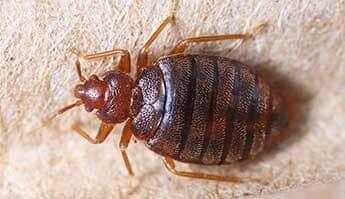
Bed Bugs
Bed bugs have earned a notorious reputation for their preference for feeding on humans during sleep. Ubiquitous in environments frequented by humans, they present a challenge due to their elusive nature and propensity for hiding in a variety of spots, including luggage and bedding.Key points to remember:
Bed bugs are nocturnal pests that inhabit areas where humans interact, including homes, offices, schools, and even public transport.
They are known to hide in suitcases, bedding, and cracks in baseboards, making them difficult to detect.
Although bed bugs do not transmit infectious diseases, their bites can cause severe itching, swelling, and redness.
Regular pest control inspections are crucial in preventing bed bug infestations.
In addition to professional inspections, vacuuming suitcases after travel, inspecting bed sheets for signs of bugs, and disinfecting second-hand items can also aid in preventing infestations.

Black Widow
Black widow spiders are globally recognized for their notorious reputation, despite a common misconception that the female consumes her male partner after mating. Their distinct bright red hourglass marking on the abdomen serves as a warning, given that their venom is fifteen times stronger than a rattlesnake's. Key points to remember:
The black widow spider has a global presence, with five species found in the United States.
Their bright red hourglass marking on their abdomen is their most distinctive feature, signaling their potent venom.
The venom of a black widow can cause health issues such as difficulty in breathing, nausea, and muscle aches, although mortality rates are generally low.
The presence of sloppy, irregular webs closer to the ground, particularly around doorways, could indicate a black widow infestation.
Attempting to remove the webs or egg sacs could be dangerous due to the potential of spider bites; contacting a professional pest control company is the safest approach to address an infestation.
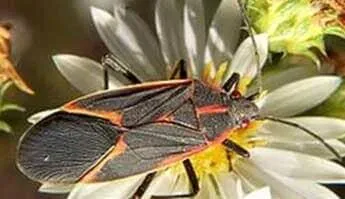
Boxelder Bugs
Boxelder bugs are often found around boxelder trees, hence their name. Native to the western United States, these bugs are seen across Canada and the eastern United States as well, especially where boxelder trees are common. Although they don't harm humans, they can be bothersome when they seek shelter in homes and garages during cold winter months. Here are the key things you need to know:
Boxelder bugs prefer living near boxelder trees and are spread throughout the US and Canada.
They are harmless to humans but can be a nuisance when they invade homes and garages to escape the cold.
These bugs are black with distinct orange or red markings on their back, and adults are about half an inch long.
Females look like males in shape but are completely red and do not have wings.
Many homeowners don't notice them until spring cleaning, so regular pest control services can help prevent these unwanted guests from settling in.

Brown Marmorated Stink Bug
The brown marmorated stink bug, a foreign invader from Eastern Asia, is a notorious pest due to its distinct smell and damaging effects on homes and crops. Recognizing them and understanding their behavior can help you keep them at bay.
Their nickname, "stink bug", comes from the foul odor they release when disturbed or crushed.
In fall, stink bugs often invade homes in large numbers to escape the chill of winter.
Stink bugs can damage gardens or crops as they tend to feed in large numbers.
Spotting significant damage to plants or finding large numbers of live or dead stink bugs might suggest an infestation.
If a stink bug infestation is suspected, it's best to contact a professional pest control company to manage the situation safely and effectively.

Brown Recluse Spider
The brown recluse spider, known for its distinctive appearance and covert behavior, is a potential danger due to its venomous bite. Keeping an eye out for signs of their presence and understanding their habits can help you prevent an unwanted encounter.
Favoring dark, dry, and warm environments, these spiders usually hide in closets, basements, and outdoor woodpiles.
Brown recluse spiders are one of the few spider species that intentionally bite when threatened.
The bite can take three or more hours to develop and up to three weeks to fully heal.
Though venomous, their venom typically triggers severe allergic reactions, primarily in elders with pre-existing conditions and very young children.
Prevention strategies include regular property inspections, avoiding leaving clothes and shoes on the ground, stacking wood piles off the ground, and leaving spaces between stacks of firewood.
If an infestation is suspected, it's best to contact a pest control professional for safe and effective removal.

Cicada Killer Wasps
Cicada Killer Wasps, solitary insects and common pests in the summertime, have a unique lifecycle involving Cicadas and are usually not aggressive towards humans.
Cicada Killers, found across the east side of the Rocky Mountains, are known as digger wasps because they burrow in soft, dry, sandy soil.
These insects rely on nectar from garden beds and flowers for nourishment.
The female Cicada Killer's lifecycle involves stinging Cicadas with paralyzing venom and then planting her larvae in the Cicada’s body.
Unlike many wasp species, Cicada Killers do not aggressively defend their burrows and only sting humans when accidentally trapped in clothing or shoes.
Despite their non-aggressive nature, Cicada Killers can be a nuisance due to property invasions. Professional pest control is advised if an infestation is suspected.

Earwigs
Earwigs, known for their long, slender bodies, wings, and distinctive pincers, are a common but harmless nuisance across the United States.
Earwigs, ranging in size from ¼ to a full inch long, can be recognized by their long bodies, six legs, long antennae, and notably, pincers on their abdomen.
Although frightening, the myth that earwigs can crawl into people's ears and tunnel into their brains is unsubstantiated.
There are over twenty different species of earwigs identified in the United States.
Some earwig species have two pairs of wings and can fly, although often only for short periods of time.
To prevent earwig invasions, regular property inspections and sealing of home entrances are recommended. Contacting a professional pest control company is advised if an infestation is suspected.
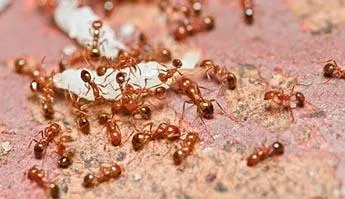
Fire Ants
Red imported fire ants, notorious for their painful stings, are a dark reddish-brown invasive species primarily found in the Southeastern United States.
Fire ants are easily recognized by their dark reddish-brown color and large mound nests, which can reach up to two to four feet in size.
This species is highly mobile and often spreads through the transfer and replanting of shrubbery and household plants.
They tend to build mounds in soft soil found around construction sites and home foundations, and can occasionally invade homes via HVAC systems.
Fire ants sting their victims, leading to painful and itchy red welts that often develop into white pustules.
Fire ant mounds are very visible and should be avoided. Regular property inspections for prevention and professional help for removal are recommended.
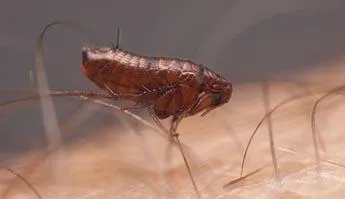
Fleas
Fleas are parasitic insects that feed on the blood of warm-blooded creatures, including pets and humans. They are known for their exceptional jumping ability and for transmitting infectious diseases.
Fleas, especially the common cat flea, can be found in households, feeding on pets and humans.
A flea's life span is around 100 days, and a female flea can produce 400-500 offspring during this time.
Fleas can jump over 150 times their height, which equates to an eight-inch vertical jump.
They primarily infest pets, wild animals, and rodents, but once in a home, they can be found on shoes, pants, or blankets.
Fleas can transmit infectious diseases like bubonic plague and murine typhus, and can also cause anemia in pets. If you suspect a flea infestation, contact a professional pest control company to safely handle the situation.

German Roach
German cockroaches are the most common species of cockroach found worldwide. They can invade any space with food and hiding places, making both commercial and residential properties susceptible.
German cockroaches are tan to light brown with two distinctive dark stripes running across their body.
They have large wings but prefer to move around on their six legs.They can often be found in kitchen and bathroom settings, where the environment is warm and humid with easy access to food and water.
Their droppings, which resemble pepper flakes, can be a sign of infestation.
These are usually found in drawers, on countertops, and in various corners of a home.If you think your home is infested with these pests, contact a professional pest control company. German cockroaches can quickly outnumber you, making professional grade equipment necessary for their removal.

Mosquito
Mosquitoes, from the Culex species, are one of the most notorious summer pests. They breed at high volumes in soft soil or stagnant water bodies, allowing them to infest virtually any property. Over 170 different species of mosquitoes are found in North America.
It's a common misconception that all mosquitoes suck blood. Only female mosquitoes feed on blood for nourishment and breeding purposes, while male mosquitoes primarily feed on plant nectar.
Female mosquitoes are adept hunters, using sensory receptors to detect the release of body heat and carbon dioxide.
Mosquitoes pose a significant health risk to humans due to their ability to carry infectious diseases such as malaria, yellow fever, dengue fever, encephalitis, and the West Nile virus.
Mosquito control starts with removing potential breeding habitats, including any standing water. It's also essential to block all potential entrances to homes, such as screen doors, windows, and any cracks.
Limit outdoor activities during dusk when mosquitoes are most active, and use insect repellents such as DEET to protect against mosquito bites and the diseases they carry.
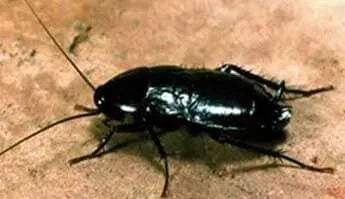
Oriental Cockroach
The Oriental cockroach, or Blatta orientalis, ironically originates from Africa, not Asia. Misleadingly identified as "water bugs" due to their preference for damp environments, these cockroaches are one of the world's largest species. They are skilled invaders, sneaking under doors, through gaps in siding, and via pipes, sewers, and drains.
Oriental cockroaches are known for their shiny black color. Adult males and females are large, but they differ significantly in appearance.
Male oriental cockroaches are smaller, growing to about 25 mm in length. They have shortened wings that leave the end of their abdominal segments exposed.
Female oriental roaches grow up to 32 mm and do not have wings, but they do have "wing pads" that cover and protect the lower parts of their abdomen. Despite having wings, male oriental cockroaches do not fly.
Indications of an oriental cockroach infestation include sighting the roaches or their egg capsules, which are large (5-10 mm) and can carry up to 16 offspring.
They are typically active in warmer months and are found in damp areas of a home or property.
An unusual sign of infestation is a distinct odor given off by oriental roaches. They use chemical signals to communicate with each other, which humans can surprisingly detect.

Termites
Subterranean termites, belonging to the family Rhinotermitidae, are the most prevalent species of termites in the United States. Recognized for their distinctive tunnels which provide access to food sources and offer protection for the colony, these termites work around the clock, utilizing their scissor-like jaws to chew through wood.
As their diet primarily consists of cellulose found in plants and trees, they are particularly fond of gnawing on your home's structure.
Subterranean termites usually swarm during spring, which marks the start of their reproductive season.
The reproductive termites then depart to establish new colonies.
Although subterranean termites are "underground" dwellers, they are typically found in moist, secluded areas above ground.
However, their colonies, which can house up to two million termites, are located underground. Subterranean termites pose a substantial financial threat to homeowners as they are the most destructive species of termite.
Over time, an unchecked colony can severely compromise the structural integrity of a building, potentially leading to its collapse.
Regular pest control inspections are vital to prevent and identify termite activity. This proactive approach can save a significant amount of money and prevent damage to your home.
If you suspect a termite infestation, it's imperative to contact a professional pest control company immediately. Swift action is crucial because every moment wasted allows the termites to consume more of your property.

Yellow Jackets
Yellow jackets are easily identifiable by their distinctive yellow and black patterned bodies. These flying insects are one of the most common stinging pests, presenting a significant danger to humans due to their aggressive, territorial nature and capacity to sting multiple times.
Yellowjackets are ubiquitous and can be found in a variety of environments, often building nests from chewed-up cellulose, which results in structures referred to as "paper carton" nests.
These nests are typically located either on the ground or within cavity spaces such as high ceilings, attics, or basements.These social insects live in colonies of up to 4,000 workers and are most populous in late summer and early autumn, following their mating season.
Yellowjackets are attracted to sweet foods, strong perfumes, and colognes, making them a frequent disruptive presence at outdoor gatherings where food is served.
Identifying a yellow jacket presence is usually straightforward due to the visibility of their nests or encounters with worker yellowjackets. Do not attempt to remove their nests, as this will provoke a swarm and result in multiple painful stings.
If you find a yellow jacket infestation on your property, it's crucial to contact a professional pest control company immediately for safe and efficient removal of the colony.



